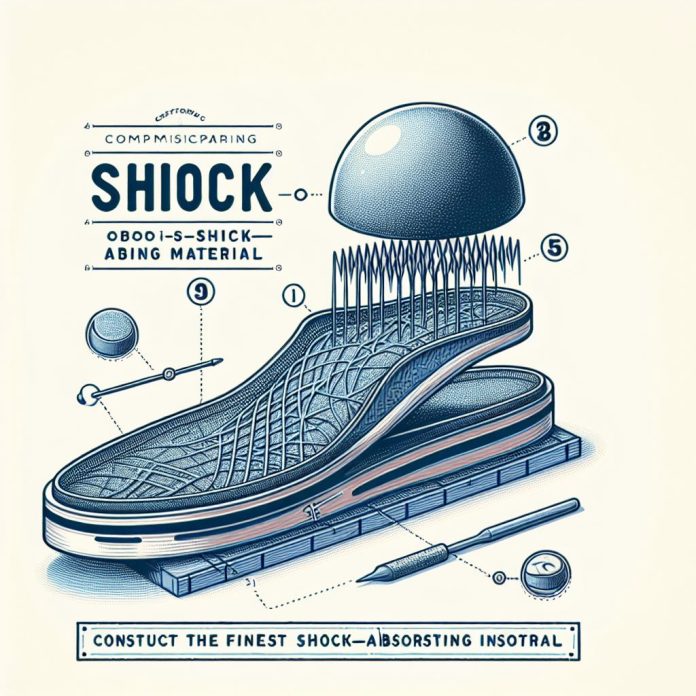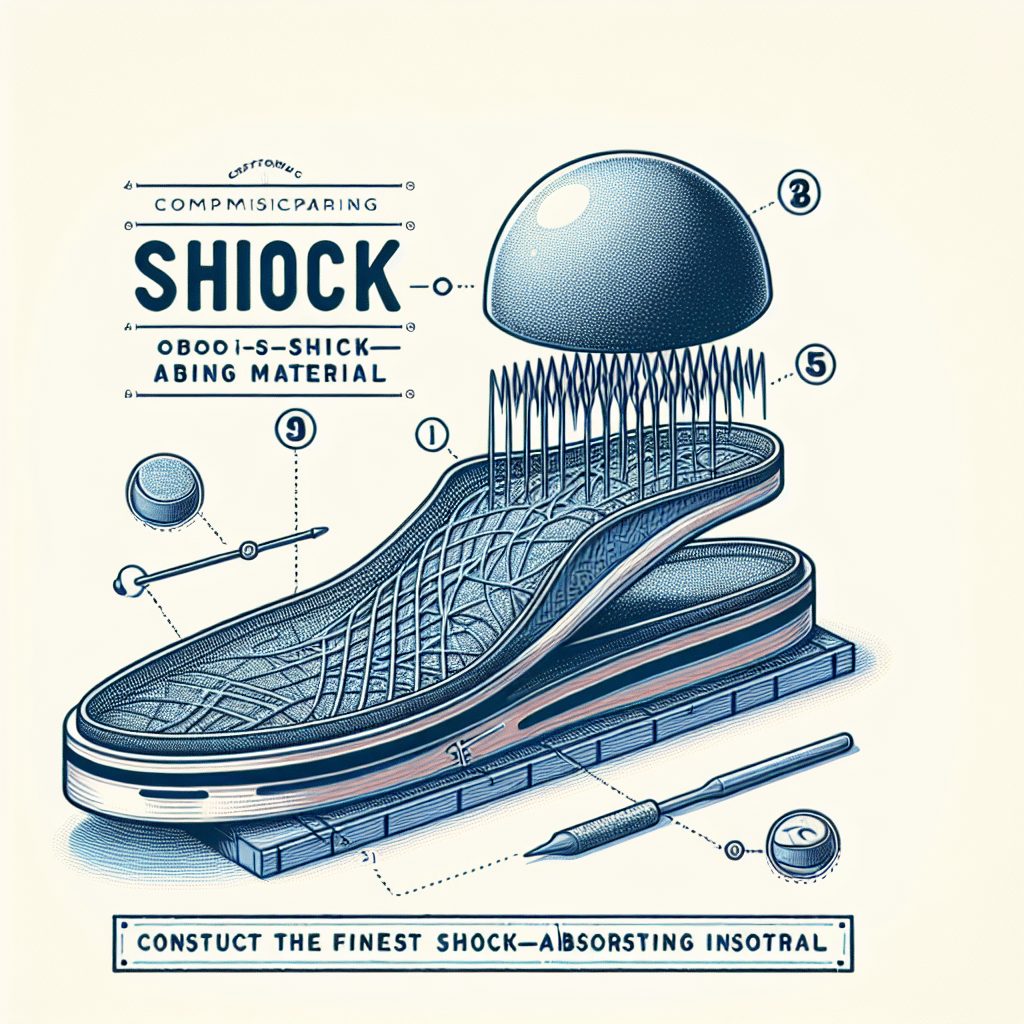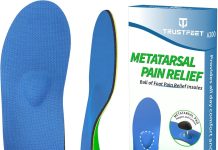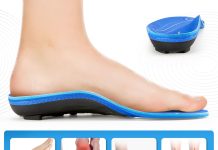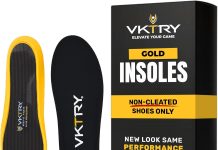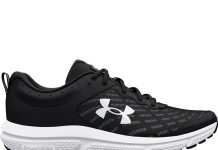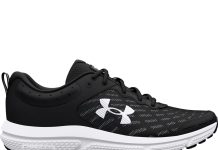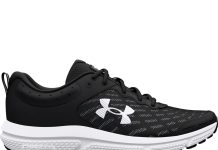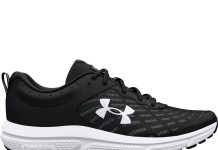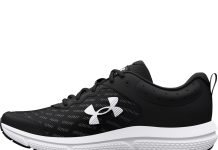Have you ever wondered what materials make the best shock absorbing insoles? Whether you’re an athlete looking for extra cushioning or simply someone who spends long hours on their feet, finding the right materials can make all the difference in comfort and support. In this article, we’ll explore the top materials that are known for their shock-absorbing properties, helping you make an informed decision for your next pair of insoles. So, let’s dive in and discover the key ingredients for that perfect step!
EVA (Ethylene-vinyl acetate)
Properties of EVA
EVA, or Ethylene-vinyl acetate, is a popular material used in insoles due to its excellent shock absorption properties. It is a lightweight and flexible material that provides cushioning and support to your feet. EVA has a high resiliency, meaning it can bounce back to its original shape after being compressed, making it ideal for shock absorption. Additionally, EVA is water-resistant, which helps to keep your feet dry and prevent odor-causing bacteria.
Benefits of EVA Insoles
EVA insoles offer several benefits to the wearer. Firstly, their shock absorption capabilities help to reduce the impact on your feet and joints, providing relief from pain and discomfort. This makes them an excellent choice for individuals who engage in high-impact activities such as running or jumping.
Another advantage of EVA insoles is their lightweight nature. They add minimal weight to your shoes, ensuring that you can move freely without feeling weighed down. This is especially beneficial for athletes and individuals who are constantly on their feet.
EVA insoles also provide cushioning and support, improving overall comfort. They distribute pressure evenly across your feet, reducing strain on specific areas and preventing the development of foot conditions like plantar fasciitis or metatarsalgia.
Drawbacks of EVA Insoles
While EVA insoles have numerous advantages, there are a few drawbacks to consider. One of the main drawbacks is that EVA is not as durable as some other materials. Over time, the insoles may experience wear and tear, resulting in a decrease in their cushioning effectiveness. Therefore, it is important to replace EVA insoles periodically to maintain optimal support and shock absorption.
Another potential drawback is that EVA insoles may not provide enough arch support for individuals with high arches or specific foot conditions. In such cases, custom orthotics may be necessary to ensure proper support and alignment.
Popular Brands Using EVA Insoles
Several popular brands incorporate EVA insoles into their footwear products. Some of these brands include Nike, Adidas, New Balance, and Dr. Scholl’s. These brands recognize the benefits of EVA insoles and utilize them to enhance the comfort and performance of their shoes.
Gel
Properties of Gel
Gel insoles, as the name suggests, are made from a gel-like material. This material is typically a combination of polymers and liquids, creating a soft and pliable substance. Gel insoles are known for their excellent shock absorption properties and their ability to conform to the shape of your feet.
Benefits of Gel Insoles
Gel insoles offer several benefits for individuals seeking shock absorption and comfort. Firstly, their gel-like composition provides superior cushioning, absorbing the impact of each step and reducing stress on your feet and joints. This can be particularly beneficial for individuals with conditions such as arthritis or plantar fasciitis.
Another advantage of gel insoles is their ability to mold to the unique shape and contours of your feet. This customized fit enhances comfort and support, reducing the risk of developing foot ailments or exacerbating existing ones. Additionally, gel insoles often have a cooling effect on your feet, providing relief to tired and sore feet.
Drawbacks of Gel Insoles
While gel insoles offer many benefits, there are a few drawbacks to consider. One of the main concerns is that gel insoles may lose their effectiveness over time. Continuous use and compression can cause the gel to break down, resulting in a decrease in shock absorption capabilities. Regular replacement of gel insoles is therefore essential to maintain their optimal performance.
Another potential drawback is that gel insoles can be quite bulky, adding extra weight and taking up more space in your shoes. This can be a concern for individuals who prefer lightweight footwear or have narrow shoes.
Popular Brands Using Gel Insoles
Gel insoles are widely used by various brands to enhance the cushioning and comfort of their shoes. Some popular brands that incorporate gel insoles include Dr. Scholl’s, Superfeet, Spenco, and Sof Sole. These brands recognize the benefits of gel insoles and ensure that their footwear products provide optimal shock absorption and support.
Memory Foam
Properties of Memory Foam
Memory foam is a viscoelastic material that is known for its ability to contour to your body shape and distribute weight evenly. It is commonly used in mattresses and pillows, but it is also utilized in insoles for its shock-absorbing properties. Memory foam insoles are made from a heat-sensitive material that softens when in contact with body heat, providing customized support and cushioning.
Benefits of Memory Foam Insoles
Memory foam insoles offer several benefits, making them a popular choice for individuals seeking comfort and shock absorption. Firstly, their ability to conform to your foot’s shape provides personalized support and cushioning. This helps to alleviate pressure points and reduces the risk of developing foot pain or discomfort.
Another advantage of memory foam insoles is their excellent shock absorption capabilities. They absorb the impact of each step, reducing stress on your feet, ankles, and knees. This can be particularly beneficial for individuals with conditions such as arthritis or those who spend long hours on their feet.
Memory foam insoles also provide superior comfort due to their soft and plush texture. They create a cushioned surface for your feet to rest on, minimizing fatigue and improving overall walking or running experience.
Drawbacks of Memory Foam Insoles
While memory foam insoles have many benefits, there are a few drawbacks to consider. One concern is that memory foam has a slower rebound rate compared to other materials. This means that it may take longer for the insoles to return to their original shape after being compressed. This slower responsiveness can affect the overall support and cushioning provided by memory foam insoles.
Another potential drawback is that memory foam insoles may retain heat, leading to sweaty feet. This can be uncomfortable, especially during hot weather or intense physical activities. Using moisture-wicking socks or choosing memory foam insoles with ventilation holes can help mitigate this issue.
Popular Brands Using Memory Foam Insoles
Memory foam insoles have gained popularity in the footwear market, and many well-known brands have incorporated them into their products. Some popular brands utilizing memory foam insoles include Skechers, Vionic, UGG, and ASICS. These brands prioritize comfort and shock absorption, ensuring that their footwear provides a supportive and cushioned experience.
Polyurethane
Properties of Polyurethane
Polyurethane, commonly referred to as PU, is a versatile material used in various industries, including insole manufacturing. PU insoles are known for their durability and shock absorption capabilities. Polyurethane is a dense and supportive material that can withstand prolonged use without losing its cushioning properties.
Benefits of Polyurethane Insoles
Polyurethane insoles offer several benefits, making them a popular choice for individuals seeking long-lasting support and cushioning. Firstly, their density and firmness provide excellent shock absorption, reducing the impact on your feet and joints. This can help alleviate pain and discomfort caused by high-impact activities or long hours of standing.
Another advantage of polyurethane insoles is their durability. They are highly resistant to wear and tear, making them a reliable option for individuals in need of sturdier insoles. Polyurethane insoles maintain their shape and cushioning properties even with consistent use, ensuring long-lasting comfort and support.
Polyurethane insoles also provide excellent arch support, which is beneficial for individuals with flat feet or high arches. The firmness of the material helps to stabilize and align the feet, reducing strain on the arches and promoting proper foot biomechanics.
Drawbacks of Polyurethane Insoles
While polyurethane insoles have numerous benefits, there are a few drawbacks to consider. One concern is that polyurethane insoles can be heavier compared to other materials. This may affect the overall weight of your footwear and can be a consideration for individuals looking for lightweight options.
Additionally, polyurethane insoles may not be as breathable as other materials, potentially leading to sweaty feet. It is crucial to choose polyurethane insoles that have ventilation holes or moisture-wicking properties to minimize this issue.
Popular Brands Using Polyurethane Insoles
Polyurethane insoles can be found in the product offerings of popular footwear brands known for their focus on comfort and support. Some renowned brands that utilize polyurethane insoles include Birkenstock, Timberland, ECCO, and Merrell. These brands prioritize durability and cushioning, ensuring that their footwear allows for optimal shock absorption and long-lasting comfort.
Air Cushion
Properties of Air Cushion
Air cushion insoles are characterized by their unique design, which incorporates pockets of air within the insole. These air pockets act as shock absorbers, providing cushioning and reducing the impact on your feet and joints. Air cushion insoles are commonly made from a combination of materials such as EVA and rubber, with the air chambers strategically placed for targeted support.
Benefits of Air Cushion Insoles
Air cushion insoles offer several benefits, making them a popular choice for individuals seeking enhanced shock absorption and comfort. Firstly, the air pockets within the insoles provide excellent cushioning, effectively reducing the impact on your feet and joints. This can be particularly beneficial for individuals engaged in high-impact activities or those with conditions such as arthritis or plantar fasciitis.
Another advantage of air cushion insoles is their lightweight nature. Despite the additional cushioning provided by the air pockets, air cushion insoles are designed to be lightweight, ensuring that they do not add significant weight or bulkiness to your shoes. This is particularly advantageous for athletes or individuals who prioritize lightweight footwear.
Air cushion insoles also offer targeted support due to the strategic placement of air chambers. These chambers provide customized cushioning and support to specific areas of your feet, reducing pressure and minimizing the risk of developing foot conditions or exacerbating existing ones.
Drawbacks of Air Cushion Insoles
While air cushion insoles have numerous benefits, there are a few drawbacks to consider. One drawback is that the air pockets within the insoles may occasionally leak or lose their cushioning properties over time. However, this can often be avoided by choosing high-quality air cushion insoles from reputable brands and ensuring proper care and maintenance.
Another potential drawback is that air cushion insoles may not provide sufficient arch support for individuals with high arches or specific foot conditions. In such cases, custom orthotics or insoles with additional arch support may be necessary for optimal comfort and alignment.
Popular Brands Using Air Cushion Insoles
Air cushion insoles are utilized by various renowned footwear brands to enhance the shock absorption and comfort of their products. Some popular brands known for incorporating air cushion insoles include Nike, Skechers, Reebok, and PUMA. These brands understand the importance of superior cushioning and support and utilize air cushion technology to provide a comfortable and enjoyable wearing experience.
Neoprene
Properties of Neoprene
Neoprene is a synthetic rubber material that is widely used in various industries, including insole manufacturing. Neoprene insoles are known for their exceptional flexibility, cushioning, and moisture-wicking properties. They are often utilized in athletic footwear and for individuals with specific foot conditions.
Benefits of Neoprene Insoles
Neoprene insoles offer several benefits, making them a popular choice for individuals seeking comfort, flexibility, and moisture control. Firstly, neoprene insoles are highly flexible, allowing for natural movement of the feet. This helps to prevent restriction and discomfort, making them suitable for individuals engaged in various physical activities.
Another advantage of neoprene insoles is their cushioning properties. They provide excellent shock absorption, reducing the impact on your feet and joints. This can be particularly beneficial for individuals involved in high-impact sports or those with foot conditions such as plantar fasciitis or Achilles tendonitis.
Neoprene insoles also excel in moisture control. The material has excellent moisture-wicking properties, effectively absorbing and evaporating sweat, keeping your feet dry and free from discomfort or odor-causing bacteria. This makes neoprene insoles ideal for individuals with sweaty feet or those seeking a more hygienic and comfortable wearing experience.
Drawbacks of Neoprene Insoles
While neoprene insoles have numerous benefits, there are a few drawbacks to consider. One potential concern is that neoprene insoles may not provide the same level of arch support as some other materials. Individuals with specific arch-related conditions may require additional support in the form of custom orthotics or insoles with built-in arch support.
Additionally, neoprene insoles may not be as durable as some other materials. Extensive use and compression may cause the material to degrade over time, resulting in a decrease in cushioning effectiveness. Regular replacement of neoprene insoles is therefore important to maintain optimal support and comfort.
Popular Brands Using Neoprene Insoles
Neoprene insoles can be found in the product offerings of various well-known athletic and outdoor footwear brands. Some popular brands that incorporate neoprene insoles into their footwear products include Columbia, Salomon, O’Neill, and Under Armour. These brands recognize the benefits of neoprene insoles and ensure that their shoes provide the desired comfort, flexibility, and moisture control.
Cork
Properties of Cork
Cork is a natural material derived from the bark of the cork oak tree. It is known for its lightweight and elastic properties, which make it an excellent choice for insoles. Cork insoles are firm yet flexible, offering support and shock absorption while conforming to the shape of your feet.
Benefits of Cork Insoles
Cork insoles offer several benefits, making them a popular choice for individuals seeking natural and sustainable materials in their footwear. Firstly, cork is a highly resilient material that provides excellent shock absorption. It helps to distribute pressure evenly across your feet, reducing the impact on your joints and minimizing the risk of foot conditions or injuries.
Another advantage of cork insoles is their ability to mold to the unique contours of your feet. The heat and pressure generated by your foot create a customized fit, providing optimal support and cushioning. This personalized fit enhances comfort and stability while promoting proper foot alignment.
Cork insoles also possess natural moisture-wicking properties, allowing them to absorb and evaporate sweat effectively. This helps to keep your feet dry and comfortable, reducing the risk of odor or bacterial growth.
Drawbacks of Cork Insoles
While cork insoles have many benefits, there are a few drawbacks to consider. One concern is that cork insoles may not have as much cushioning as some other materials. Individuals seeking high levels of cushioning may require additional inserts or choose insoles made from materials with greater shock absorption properties.
Another potential drawback is that cork insoles may not be as durable as some synthetic materials. Over time, cork may wear down and lose its cushioning effectiveness. However, with proper care and maintenance, cork insoles can last for a reasonable period before needing replacement.
Popular Brands Using Cork Insoles
Cork insoles are used by various brands that prioritize natural and sustainable materials in their footwear products. Some popular brands known for incorporating cork insoles include Birkenstock, Vionic, Naot, and OOFOS. These brands recognize the benefits of cork insoles and ensure that their footwear offers the desired comfort, support, and sustainability.
Thermoplastic Rubber (TPR)
Properties of TPR
Thermoplastic Rubber, commonly known as TPR, is a synthetic material that combines the properties of rubber and plastic. TPR insoles offer a combination of flexibility, durability, and cushioning. They are known for their excellent shock absorption and resistance to wear and tear.
Benefits of TPR Insoles
TPR insoles provide several benefits, making them a popular choice for individuals seeking long-lasting cushioning and support. Firstly, TPR insoles offer excellent shock absorption, reducing the impact on your feet and joints. This can help alleviate pain and discomfort caused by high-impact activities or prolonged periods of standing or walking.
Another advantage of TPR insoles is their durability. TPR is a resilient material that can withstand significant wear and tear without losing its cushioning properties. This makes TPR insoles suitable for individuals seeking long-lasting support and cushioning.
TPR insoles also offer flexibility, allowing for natural movement of the feet. This can help prevent foot restriction and discomfort, ensuring a more comfortable wearing experience.
Drawbacks of TPR Insoles
While TPR insoles have several benefits, there are a few drawbacks to consider. One concern is that TPR insoles may not be as lightweight as some other materials. This can add weight and bulkiness to your footwear, which may be a consideration for individuals who prefer lighter footwear or have narrow shoes.
Additionally, TPR insoles may not provide as much breathability as some other materials. This can lead to sweat accumulation and discomfort, particularly during hot weather or intense physical activities. Choosing TPR insoles with ventilation holes or moisture-wicking properties can help mitigate this issue.
Popular Brands Using TPR Insoles
TPR insoles are utilized by various footwear brands, particularly those that prioritize durability and cushioning. Some popular brands that incorporate TPR insoles into their products include Clarks, Rockport, Keen, and Dr. Martens. These brands recognize the benefits of TPR insoles and ensure that their footwear offers reliable support, cushioning, and long-lasting performance.
Silicone
Properties of Silicone
Silicone is a synthetic material known for its soft and pliable texture. It is often used in various industries, including insole manufacturing. Silicone insoles offer excellent shock absorption and comfort due to their unique properties.
Benefits of Silicone Insoles
Silicone insoles provide several benefits, making them a popular choice for individuals seeking cushioning and support. Firstly, silicone insoles offer superior shock absorption, reducing the impact on your feet and joints. This can help alleviate pain and discomfort caused by high-impact activities or conditions such as arthritis or plantar fasciitis.
Another advantage of silicone insoles is their unparalleled softness and flexibility. They conform to the shape of your feet, providing customized support and cushioning. This personalized fit enhances comfort and stability, ensuring a more enjoyable wearing experience.
Silicone insoles also possess excellent heat and cold resistance, making them suitable for all seasons. Regardless of the weather, silicone insoles maintain their cushioning properties and do not become too rigid or too soft.
Drawbacks of Silicone Insoles
While silicone insoles have many benefits, there are a few drawbacks to consider. One potential concern is that silicone insoles may not provide as much arch support as some other materials. Individuals with specific arch-related conditions may require additional support in the form of custom orthotics or insoles with built-in arch support.
Another drawback to consider is that silicone insoles tend to retain heat, potentially causing sweaty feet. This can be uncomfortable, especially during hot weather or intense physical activities. Using moisture-wicking socks or choosing silicone insoles with ventilation holes can help mitigate this issue.
Popular Brands Using Silicone Insoles
Silicone insoles can be found in the product offerings of various footwear brands that prioritize cushioning and support. Some popular brands known for incorporating silicone insoles include Spenco, Superfeet, Sof Sole, and HappyStep. These brands recognize the benefits of silicone insoles and ensure that their footwear products provide superior shock absorption and long-lasting comfort.
Poron
Properties of Poron
Poron is a high-performance cushioning material that offers superior shock absorption and energy return. It is a flexible and resilient material that can withstand repeated impact without losing its cushioning properties. Poron insoles are commonly used in athletic footwear and shoes that require exceptional shock absorption.
Benefits of Poron Insoles
Poron insoles offer several benefits, making them a popular choice for individuals seeking advanced cushioning and support. Firstly, Poron provides excellent shock absorption, reducing the impact on your feet and joints. This can help alleviate pain and discomfort caused by high-impact activities, such as running or jumping.
Another advantage of Poron insoles is their energy return properties. Poron material compresses upon impact and then quickly rebounds to its original shape, providing a spring-like effect. This energy return helps propel your feet forward, boosting overall performance during physical activities.
Poron insoles also offer long-lasting comfort due to their superior durability. The material can withstand continuous compression and retains its cushioning properties over time, ensuring reliable support and shock absorption even with consistent use.
Drawbacks of Poron Insoles
While Poron insoles have numerous benefits, there are a few drawbacks to consider. One concern is that Poron insoles can be quite expensive compared to some other materials. The advanced cushioning and performance properties of Poron contribute to its higher price point. However, individuals seeking exceptional shock absorption and energy return may find the investment worthwhile.
Another potential drawback is that Poron insoles may not provide as much arch support as some other materials. Individuals with specific arch-related conditions may require additional support in the form of custom orthotics or insoles with built-in arch support.
Popular Brands Using Poron Insoles
Poron insoles are utilized by various renowned footwear brands that prioritize advanced cushioning and performance. Some popular brands known for incorporating Poron insoles include New Balance, Under Armour, Wolverine, and Red Wing Shoes. These brands understand the benefits of Poron insoles and utilize them to enhance the comfort, support, and athletic performance of their footwear products.
In conclusion, there are several materials commonly used in shock-absorbing insoles, each with its own unique properties and benefits. EVA, gel, memory foam, polyurethane, air cushion, neoprene, cork, TPR, silicone, and Poron all offer varying levels of shock absorption, comfort, support, durability, and moisture control. When choosing insoles, it is important to consider your specific needs, foot type, and activities to find the material that best suits you. Additionally, popular brands such as Nike, Adidas, Birkenstock, Spenco, and New Balance incorporate these materials into their insoles, ensuring you have a wide range of options to choose from. Ultimately, investing in high-quality shock-absorbing insoles can greatly improve your comfort, reduce pain, and enhance your overall foot health.

